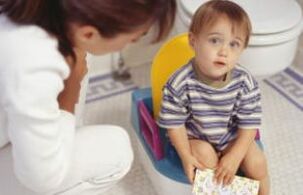Parasitosis is a separate group of diseases caused by protozoa or helminths (worms). According to statistics, helminthiasis and giardiasis occur in 78-80% of children of preschool and school age. Parasitic worms and arthropods poison the body with the products of their vital activity, in connection with which damage to vital systems and organs is observed.
Giardia and worms: differences and similarities

Many people mistakenly believe that Giardia is a type of helminth that parasitizes the gastrointestinal tract. Both these and other microorganisms are parasites and enter the body in the same way. However, worms and giardia are representatives of different classes, differing in structure and the degree of damage to the health of the child:
- Giardia (giardia) are flagellated protozoa that parasitize the mucous membrane of the small intestine. Single-celled microorganisms can exist in two forms:
- pore - the transformation of giardia into a cyst when unfavorable conditions occur. In this way, it preserves its activity in the external environment and, in the case of penetration into a living organism, begins to develop;
- vegetative: active development of giardia within the intestine, from which it receives all the necessary nutrients for growth and reproduction.
- Helminths (worms) are parasitic worms that can infect almost all types of tissues. There are more than 400 types of worms, but they all belong to one of the following types:
- tapeworms - echinococci, broad litinets, pork tapeworms;
- trematodes - trematodes;
- intestinal worms: toxocara, pinworms, whipworms.
Infection of children with parasites occurs when drinking water or food contaminated with cysts and eggs. The carriers of helminths eggs and lamblia cysts are cats and dogs. The development of parasitosis is facilitated by mosquitoes, flies and other insects that carry eggs of roundworms, echinococci, etc. on the proboscis.
The clinical picture with giardiasis (giardiasis)
Parasitic infection is most often diagnosed in children 1 to 4 years old. In about 30% of cases, parasitosis is asymptomatic and is detected during the diagnosis of another disease during laboratory tests. Typical symptoms of giardiasis in children include:
- decreased appetite;
- flatulence;
- dizziness;
- bad dream
- weightloss;
- violation of feces;
- irritability;
- pain in the navel;
- epigastric discomfort;
- enlargement of the liver;
- dyskinesia of the biliary tract;
- Allergic dermatitis.
In young children, giardiasis is more serious than in adults. Intoxication of the body with giardia waste products leads to a change in the complexion, the appearance of acne and dark circles under the eyes. A blood test reveals an increased concentration of eosinophils in the plasma. Parasites are not always detected in feces, which is associated with the peculiarities of their development cycle.
Clinical picture with helminthiasis.

Symptoms of helminthiasis appear 2 to 4 weeks after the parasites enter the child's body. In about 1/3 of patients, the signs of parasitosis are weakly expressed, however, the toxic effect of its waste products does not stop. The main manifestations of helminthiasis in children include:
- feverish condition;
- exudative rash;
- swelling of the face;
- loose stools;
- lymphadenopathy;
- flatulence;
- stomach cramps;
- nervousness;
- insomnia;
- chronic fatigue
Note: the development of complications that accompany helminthiasis is promoted by immunodeficiencies, vitamin deficiencies, and mineral deficiencies.
With massive invasions, vital organs are damaged, as evidenced by the development of myocarditis, pleuropneumonia, meningoencephalitis, etc. The degree of eosinophilia in helminthiasis depends on the immune status of the patient and the intensity of the infection.
Treatment of giardiasis
Giardiasis therapy is not started with the use of antiparasitic drugs, as this can lead to the development of serious toxic allergic complications. In this sense, the treatment is carried out in three stages:
- Compliance with the diet program for 14 days helps to eliminate toxicosis. To improve the enzymatic activity of the intestines and increase the general immunity, it is necessary to include cereals, cereals, nuts and vegetable oil in the diet. To reduce the concentration of toxins in the blood, children are prescribed enterosorbents, choleretics, and antihistamines;
- Intensive antiparasitic therapy contributes to the elimination of active lamblia and cysts. For the destruction of protozoa the following are usually used: "Nifuratel", "Metronidazole", "Ornidazole";
- To improve intestinal motility, it is recommended to include fermented dairy products, cereals and baked apples in the menu. You can strengthen the immune system of the child with the help of prebiotics, multivitamins and herbal adaptogens.
In the acute course of giardiasis, a one-stage treatment regimen with antiparasitic drugs is prescribed. The most effective are: "Albendazole", "Tinidazole", "Mepacrine", "Furazolidone", etc.
Helminthiasis treatment

The principles of deworming are determined by the type of parasite that caused the development of the disease. The main goal of therapeutic and prophylactic measures is to reduce the number of helminthic invasions in the intestine and to strengthen nonspecific immunity. The following groups of drugs can be used to destroy worms:
- antinematodal - "mebendazole", "thiamazole";
- anticestoid - "praziquantel", "niclosamide";
- protivotrematodoznye.
Many of the above medications can cause side effects such as anemia and intestinal bleeding. To avoid deterioration of health during therapy, it is recommended to use "Filgrastim", "Dioxomethyltetrahydropyrimidine", "Ursodeoxycholic acid", "Colespitol".
Conclution
Giardia and helminths are representatives of different classes of parasitic microorganisms that enter the human body in the same way. The clinical manifestations of helminthiasis and giardiasis are very different, which is associated with different principles of their development and the location of invasions. Antiparasitic therapy for diseases includes various drugs aimed at destroying certain types of pathogens.











